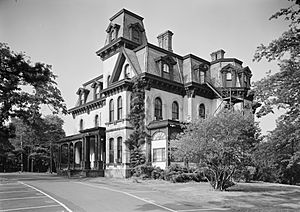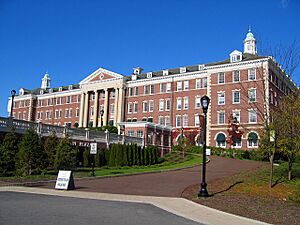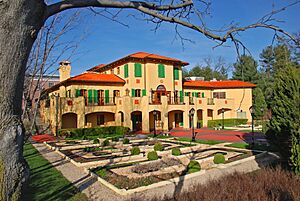History of the Culinary Institute of America facts for kids
The Culinary Institute of America (often called CIA) is a famous school where people learn to become amazing chefs and food experts. Its story began in 1946 in New Haven, Connecticut. It was first created to help soldiers returning from World War II learn new skills. As more and more students wanted to join, the school moved to a bigger campus in Hyde Park, New York, in 1970. This is still its main home today.
The CIA started giving out college degrees in 1971 and advanced degrees in 1993. Over the years, it has opened other campuses in places like St. Helena, Texas, Singapore, and Napa.
Contents
How the CIA Began: 1946–1969
The school was first called the New Haven Restaurant Institute. It was started by the New Haven Restaurant Association, with help from food educators Frances Roth and Katharine Angell. The very first classes were held on May 22, 1946. It was a special training school for soldiers coming back from World War II.
Frances Roth became the first director, and Katharine Angell was the first president. She helped the school build strong connections with New Haven and especially with Yale University. The first group of students had fifty people and three teachers: a food planner, a baker, and a chef.
At first, the school was in a small storefront. But in 1947, it moved to a larger building. With help from Yale University, the school bought the Davies mansion in New Haven. This building became known as Angell Hall. It even had a private chapel, which Katharine Angell thought was important for cooking schools.
In 1947, the school changed its name to the Restaurant Institute of Connecticut. Then, in 1951, it changed its name again to the Culinary Institute of America, which it is still called today.
Moving to Hyde Park and Growing: 1970s–1990s
By 1969, about 1,000 students were attending the school. The New Haven campus was too small for so many students. So, the school sold its New Haven property to Yale University. In 1970, it bought a large building called St. Andrew-on-Hudson in Hyde Park, New York. This building used to be a training center for priests. The school bought the five-story building with 150 rooms and 80 acres of land.
The school started operating at the Hyde Park location in 1972. In 1973, the school opened a fancy restaurant called the Epicurean Room, which later became the Escoffier Restaurant. This restaurant earned high ratings from famous food guides.
To house its many students, the college built three dorms in 1974. A fourth dorm, Hudson Hall, was built in 1986. In 1988, the school opened the General Foods Nutrition Center, which included a student-run cafe. That same year, it opened the Takaki School of Baking and Pastry, which had many kitchens and classrooms for baking and pastry making.
In 1993, the school was allowed to offer advanced college degrees. It also opened a new library and a theater. In 1998, a new Student Recreation Center opened for students to relax and exercise.
Recent History: 2000–Present
In 2000, the Apple Pie Bakery Café opened. The Colavita Center for Italian food and wine opened the next year. More dorms were built at the Hyde Park campus in 2004.
The CIA continued to grow and open new campuses. In 2008, it opened its third campus in San Antonio, Texas. Two years later, in 2010, the CIA opened a campus in Singapore.
The school also added new degree programs. In 2012, the CIA started offering a bachelor's degree in culinary science. In 2014, it added a bachelor's degree in applied food studies. In 2015, the college made its recreation center bigger and added a new dining area for students called The Egg.
In 2015, the college also bought part of Copia, a food museum in Napa, California. In 2016, this became the the Culinary Institute of America at Copia campus, which includes the CIA's new Food Business School.
Around 2008, some teachers and students at the CIA raised concerns about the school's equipment and class sizes. They felt that some things needed to be updated or improved. The school listened to these concerns and worked to make improvements in areas like scheduling and curriculum. The school also apologized for an issue with the campus newspaper, allowing it to report fully on the situation.
In 2013, about 90 students held a protest. They were concerned about a school rule that required students to have professional kitchen experience before applying. They wanted to make sure that all students joining the school had a good background in cooking. The students signed letters and gave speeches to share their views.
In 2017, the college announced it would offer a new degree in Hospitality Management starting in 2018. This degree helps students learn how to manage hotels and restaurants.
Student Demographics
The number of women attending the Culinary Institute of America has grown a lot since it first opened. In the very first graduating class, there was only one woman among 50 students. By 1980, about 20% of students were female. This number rose to 30% by 2000 and 40% by 2006. In 2017, for the first time, women made up the majority of students at the school, with 51.6%.
While some people think women were not allowed until 1970, there were women in the first few classes. However, from 1966 to 1971, women were not admitted. This was because the school's New Haven campus had limited space and facilities at that time.
See also
- Betts House
- Hyde Park campus of the Culinary Institute of America
- The Culinary Institute of America at Greystone
- The Culinary Institute of America at Copia





